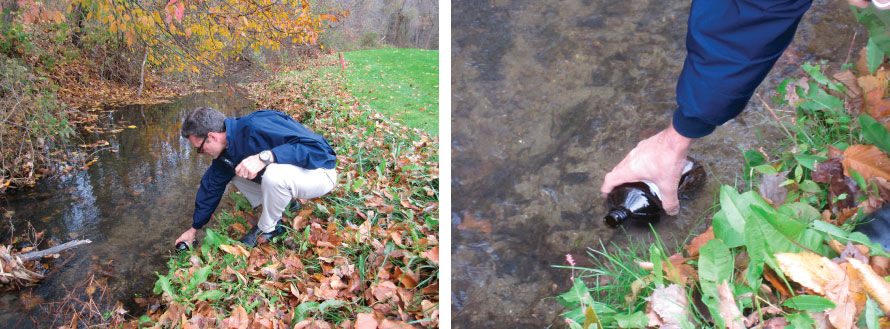Aligning management programs with established, research-based BMPs is the first step to ensuring water quality protection. Water quality monitoring can confirm the effectiveness of a BMP-based program.
Golf course superintendents wanting to develop and implement a water quality monitoring program to document the water quality conditions should first review available baseline water quality data. Baseline data can be assessed to determine the likely origin of contaminants, measure the extent of sedimentation and nutrient inputs, and estimate the potential impacts to surface water and groundwater. Following implementation of BMPs, routine monitoring can be used to measure water quality improvements and identify any areas where corrective actions should be taken.
Water quality monitoring can also demonstrate the presence of water quality issues inherent in water as it enters a golf course property. For example, in Suffolk County extensive laboratory testing for contaminants has shown that groundwater entering the golf course already has extremely high nitrate levels near or greater than the regulatory limit. The county also collects surface water samples and shares the test reports with superintendents.
Sources of Existing Information
Several sources of existing surface and groundwater monitoring data may be available, including:
- Soil and Water Conservation Districts – Comprehensive water quality management programs; may be willing to test surface water and assist in installation of groundwater monitoring wells. SWCD listings for NYS are available at: http://www.nys-soilandwater.org/contacts/county_offices.html
- NYSDEC – Conducts a groundwater monitoring program in coordination with USGS. http:// www.dec.ny.gov /docs/water_pdf/top10nutloading.pdf
- USGS – Reports results of groundwater monitoring and compares to EPA and NYSDOH standards. The USGS has completed testing and published reports for most of the major watersheds in the state. http://ny.water.usgs.gov/projects/305b/.
- County Water Authorities – Maintain and test community water wells and may have additional test data from other points within the watershed.
Developing a Water Quality Monitoring Program
Developing a water quality monitoring program can include both groundwater monitoring and surface water monitoring. The data from this periodic monitoring can be used to identify issues that may need corrective actions. In addition, water quality monitoring of irrigation sources (particularly water supply wells and storage lakes) provides valuable agronomic information that can inform nutrient and liming programs. A water quality monitoring plan should identify appropriate sampling locations, frequency, and monitoring parameters.
Groundwater monitoring from wells located at the hydrologic entrance and exit from the course may be the best way to evaluate a golf course’s impact on water quality. If groundwater monitoring data from these locations are not available from existing sources, monitoring wells can be installed by private companies. Installing groundwater monitoring wells can be relatively expensive, but the expense may be justified in certain cases where the origin of contamination needs to be determined through comparison of water quality entering and exiting the property. To identify the appropriate site for monitoring wells, groundwater flow is required. In some areas of New York, groundwater flow maps have been developed, but may not be available at a fine enough scale for an individual golf course. Experienced environmental engineering firms or USGS can assist in determining suitable monitoring well locations.
Testing protocols can be simplified to test only those parameters that are directly influenced by course management, including organic and inorganic levels of nitrogen and phosphorus and a pesticide screen for certain pesticides used on the course. NYSDEC pesticide reports provide the necessary documentation for pesticides used. The USGS also offers contract services to advise on sampling and testing of water samples. SWCD offices can also provide guidance on groundwater testing programs.
Surface water monitoring can include the laboratory testing of a number of different physical and chemical parameters to assess water quality. In addition, the sampling of macrobenthic invertebrates can be used as a relative assessment tool for stream health. Sampling of surface waters can be conducted by golf course staff or volunteer monitoring groups.
 Golf course staff can easily sample surface water. Source: Ken Benoit.
Golf course staff can easily sample surface water. Source: Ken Benoit.
A number of references for detailed information on planning a water quality monitoring program on golf courses can be used to plan a site-specific water monitoring program:
- Environmental Stewardship Guidelines (Oregon GCSA, 2009) includes a highly detailed chapter on water quality monitoring specific to golf turf. http://www.ogcsa.org/Pages/environmental/ogcsa-guidelines.html
- Environmental Best Management Practices for Virginia’s Golf Courses (Virginia GCSA, 2012) includes a detailed chapter on water quality monitoring and an example water quality monitoring report appendice. http://www2.cybergolf.com/sites/images/373/Virginia-BMP-Full-Report-final.pdf
- A Guide to Environmental Stewardship on the Golf Course (Audubon International, 2002)
